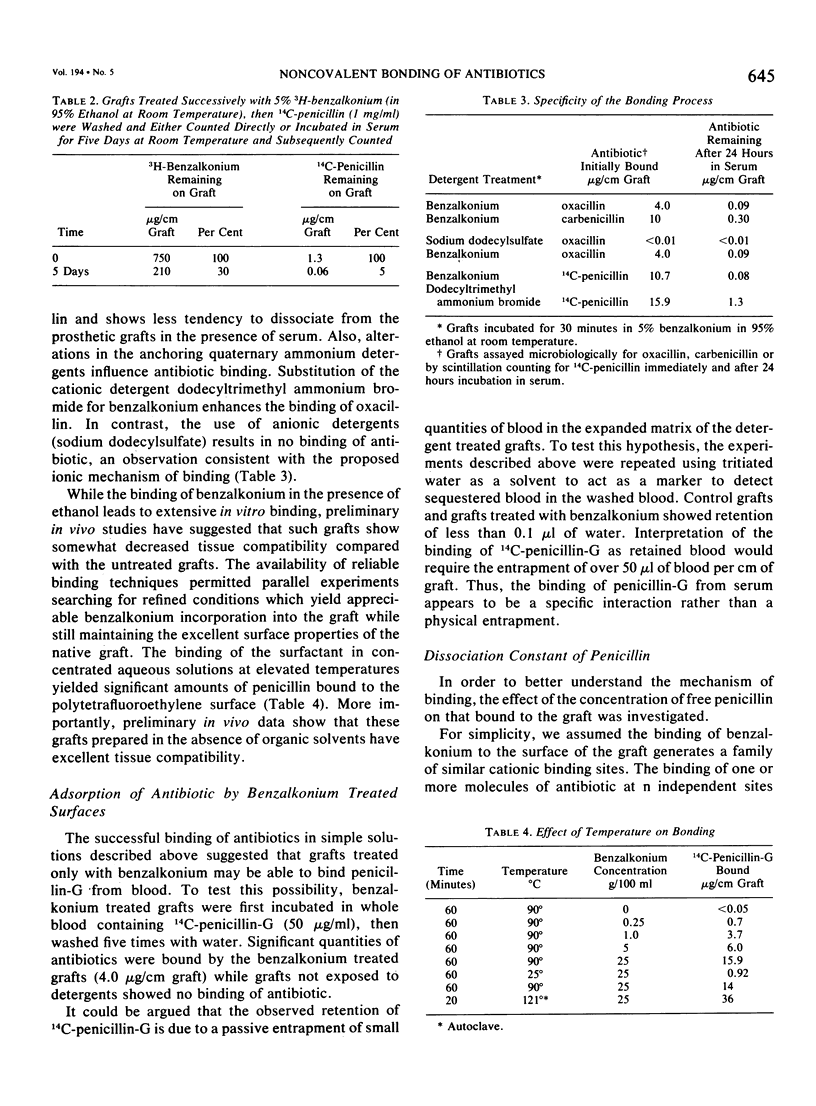Abstract
This study evaluates the noncovalent bonding of anionic antibiotics to polytetrafluoroethylene grafts using benzalkonium chloride as a cationic anchor. The binding of radiolabeled surfactants and antibiotics was evaluated by liquid scintillation and in an in vitro microbiologic assay against Staphylococcus aureus. Significant quantities of antibiotic were bound when the grafts were pretreated with benzalkonium in ethanol or aqueous solution at elevated temperature. Bound antibiotic is stable in aqueous salt solutions, but slowly dissociates in the presence of blood or serum. The ionic nature of the bonding process is clarified by the use of a variety of antibiotics and surfactants with complementary charges. The ability of the benzalkonium treated grafts to adsorb antibiotic from blood is, likewise, demonstrated and the possibility of concomitantly binding heparin and antibiotic simultaneously is evaluated. These studies support the ability to noncovalently bond antibiotics to polytetrafluoroethylene surfaces and form the basis of eventually utilizing these surfaces in the prevention of vascular prosthetic infections.
Full text
PDF





Selected References
These references are in PubMed. This may not be the complete list of references from this article.
- Goldstone J., Moore W. S. Infection in vascular prostheses. Clinical manifestations and surgical management. Am J Surg. 1974 Aug;128(2):225–233. doi: 10.1016/0002-9610(74)90097-x. [DOI] [PubMed] [Google Scholar]
- Jacques L. B. Heparin: an old drug with a new paradigm. Science. 1979 Nov 2;206(4418):528–533. doi: 10.1126/science.386509. [DOI] [PubMed] [Google Scholar]
- Jagpal R., Greco R. S. Studies of a graphite-benzalkonium-oxacillin surface. Am Surg. 1979 Dec;45(12):774–779. [PubMed] [Google Scholar]
- Krause A. H., Ferguson T. B., Weldon C. S. Thoracic aneurysmectomy utilizing the TDMAC-heparin shunt. Ann Thorac Surg. 1972 Aug;14(2):123–132. doi: 10.1016/s0003-4975(10)65210-1. [DOI] [PubMed] [Google Scholar]
- Roon A. J., Malone J. M., Moore W. S., Bean B., Campagna G. Bacteremic infectability: a function of vascular graft material and design. J Surg Res. 1977 May;22(5):489–498. doi: 10.1016/0022-4804(77)90031-2. [DOI] [PubMed] [Google Scholar]
- WHIFFEN J. D., GOTT V. L. IN VIVO ADSORPTION OF HEPARIN BY GRAPHITE-BENZALKONIUM INTRAVASCULAR SURFACES. Surg Gynecol Obstet. 1965 Aug;121:287–290. [PubMed] [Google Scholar]
- Willwerth B. M., Waldhausen J. A. Infection of arterial prostheses. Surg Gynecol Obstet. 1974 Sep;139(3):446–452. [PubMed] [Google Scholar]


